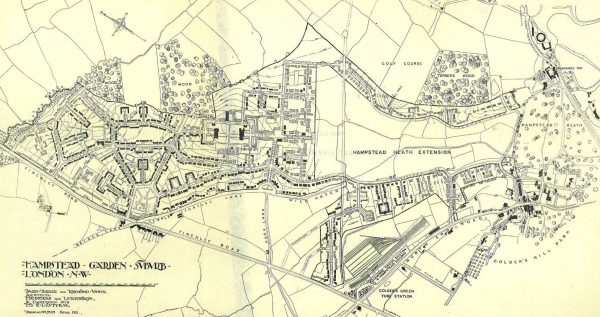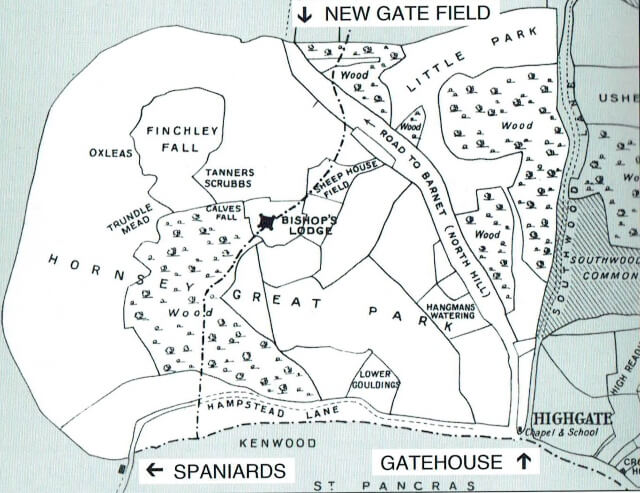Article by Tony Roberts, first published in The Archer, August/September 1998
At the turn of the century, when much of East Finchley’s corner of the Finchley triangle was built or projected, southward across the valley of the Mutton Brook remained mostly rural.
The left bank at the bottom of the valley, Saxon Bleccanham, had belonged to Westminster Abbey, along with the rest of Hendon, since the Norman Conquest. When he dissolved the monasteries, Henry VIII gave the easternmost land to Eton College, founded by his grandfather. This land became Wyldes Farm.
The imminent arrival of the Charing Cross, Euston and Hampstead Railway in Golders Green with its station at North End precipitated Henrietta Barnett into a bid to protect the area adjacent to her home at Spaniards End from piecemeal development. Through the Heath Extension Council she attempted to raise the money to purchase 80 acres from the College for the Heath. Initial donations were not promising and Henrietta enlarged her plan. By purchasing the whole estate the further 243 acres could be developed as an enlightened housing experiment, using the Heath Extension as an amenity on its doorstep.
The Barnetts were philanthropists who believed that rich and poor could live together in harmony if only the right surroundings could be provided, and here was the chance to prove it in conjunction with a similarly enlightened LCC. By siting large expensive properties close to the extension, maximising their value, the profits could be used to subsidise the higher density workers’ properties at the lower value end of the site. Even with large LCC contributions, finance was tight and the project was only saved by allowing additional housing to be built on the borders of the Extension. Contacts were signed in Spring 1907.
The garden style of development, initiated by enlightened Quaker industrialists was already in vogue. New Earswick (York) and Letchworth Garden City were to be a major influence and Raymond Unwin, site architect, had been involved at both. Careful attention was to be paid to all aspects of design and layout. A bill was passed through parliament to exempt the suburb from some of Hendon’s planning regulations, allowing some narrower roads and a more village type atmosphere.
The posh settlement was built around a square on the highest point with fine churches and an institute and Sir Edwin Lutyens was commissioned to design the more formal buildings. The artisan quarter was round the back at Temple Fortune.

Almost before the ink was dry on the original contract for Hampstead Garden Suburb changes were afoot.
The Garden Suburb Development Company was formed by the Trust to assist the design and let contracts for the construction of houses and other features. Concentrating on the posher areas it was successful for a time, but was eventually disbanded.
The other development companies were companies in which tenants participated, making an initial investment of £5 and a commitment to a further £5. This requirement, combined with spiralling land costs, effectively ruled out the original intention to provide homes for the poor and rich alike. These companies were known collectively as the Co-Partners.
The original plans for a rural layout based on informal curves started to give way to a more formal structure at the centre, possibly due to the influence of Edwin Lutyens, the architect for the Central Square. Lutyens had differences with Henrietta Barnett over style. He favoured Italianate architecture for the church buildings whereas Barnett wanted Gothic. The result proved a unique but successful compromise. Lutyens was eventually squeezed out before completing all his original brief. The North Square shows great attention to detail. The arch, the arrangement of windows for rooms in the roof, the continuation of the cornice line on the buildings descending Erskine Hill are good examples.
Before Central Square was complete the HGS Trust acquired from the Ecclesiastical Commissioners a lease on land in neighbouring East Finchley, stretching from here down the hill to the Mutton Brook. This included Little and Big Woods, opened to the public, although it would appear Big Wood was clipped to make way for the fan-shaped extension of the formal layout eastwards.
The Co-Partners negotiated a lease on most of the remaining rural land up the valley, to the Bishop’s Avenue and the houses on East End Road. Subsequently the Trust sold many of its rights on the East Finchley land to the Co-Partners, including the right to use the name Hampstead Garden Suburb.
The relaxing of control and the increasingly commercial stance of the Co-Partners meant that the East Finchley part of the Suburb, the largest in area, lacks the charm and individuality of the original. After many battles, the Suburb is now on a different footing.
Reproduced by kind permission East Finchley Newspapers CIC.
The complete story is told by Mervyn Miller and A Stuart Gray in their book “Hampstead Garden Suburb”.



